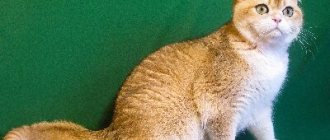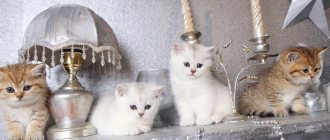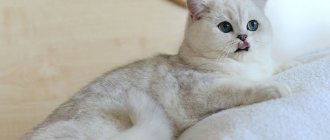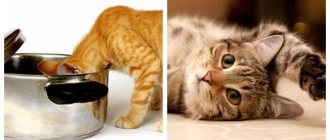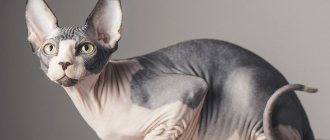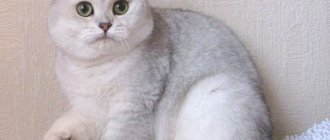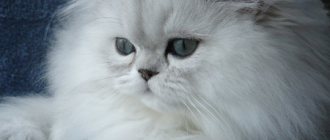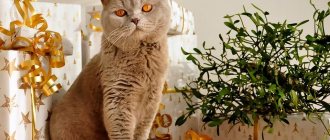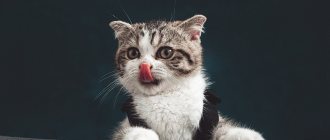History of the breed and its origin
As the name of the breed suggests, this cat was bred in England.
The cat owes its unusual color to the British smoke and Persian cats.
A huge selection work was carried out to fix the frequency of color among representatives of the breed.
In 1889, a cat with a uniform color was obtained. This cat received many awards and titles of that time. The British chinchilla has become one of the most beloved breeds among the aristocracy.
Only well-off people could afford to buy such a cat.
Now representatives of the breed have an emerald tint to the iris. It took breeders a long time to achieve this color. Thanks to crossing with Persians, a remarkable result was achieved.
A little later, the golden chinchilla was bred.
And also a noble blue eye color appeared. Sky-colored irises are usually found in silver chinchillas.
There is a second version of the appearance of British chinchillas.
According to her, this breed of cats was obtained thanks to a large number of crossings of British cats with each other.
There is also a version that the breed originated in America. These events occurred approximately simultaneously.
Possible diseases
The health of cats directly depends on heredity; immunity is passed on from the parents. In general, chinchillas are in good health, but may be prone to certain diseases.
Retinal atrophy is damage to light-sensitive receptors in the retina of the eye. Symptoms include dilated pupils, shiny eyes, and sudden onset night blindness. The animal stops seeing in the dark, and in advanced cases can completely lose vision. Unfortunately, there is no effective treatment for atrophy
It is important to maintain eye hygiene to prevent dirt from accumulating on them.
Caries. For prevention, it is important to brush your teeth, and if caries is detected, contact your veterinarian immediately.
Hypertrophied cardiopathy is a heart disease in which the wall of the ventricle thickens
May cause the cat to develop heart failure or thromboembolism. It can only be detected using ultrasound. At the beginning of the disease, the animal may notice shortness of breath and fatigue. Timely diagnosis and timely treatment begin guarantee a favorable outcome.
Polycystic kidney disease is a disease of the genitourinary system in which cysts appear in the kidneys. It is very difficult to recognize the manifestations of the disease at the initial stage, but still, if it is possible, then surgical removal of the cyst is performed. But most often, symptoms become noticeable only when the formations greatly increase in size and the cat experiences pain.
If cysts are detected by simple palpation of the abdominal cavity, then the operation is pointless. It is no longer possible to save the animal, since the kidneys cannot function normally. Only a special diet and drug therapy prescribed by a veterinarian can alleviate suffering. They will be able to extend the life of the pet.
Appearance
In appearance, chinchillas resemble the British cat breed. The main difference is the luxurious fur and thick undercoat. The weight of cats usually does not exceed 8 kg. And cats weigh almost half as much (3-4 kg).
The body of the representatives of the breed is quite large.
The chest is wide. Cats are more graceful than cats, but still the body of both is powerful. The limbs are shorter than those of British breed cats. Proportional in size. The paws are large. The tail is not fluffy and is not long.
The tip of the tail is rounded.
The head is rounded, the cheekbones are wide, and the “pads” under the mustache are well defined. The ears are medium in size. They are located widely from each other.
The nose is small, wide, but not flattened.
The neck is not long. The eyes of British chinchillas are large in size and shallow-set.
The standard eye color for chinchillas is blue and emerald green.
Wool is the special pride and distinction of British chinchillas. It is dense, with a thick undercoat, silky and soft to the touch. Reminds me of arctic fox fur.
These beauties have a pronounced rim around their eyes and nose.
Very often the pads on the paws are painted the same color.
These cute creatures are the owners of a chic “fur coat”.
They look elite and luxurious.
What is the price
The silver chinchilla cat breed is included in the middle price category. The cost of a kitten ranges from 30 thousand rubles. up to 70 thousand rubles. There are 3 price categories:
- pet class - chinchilla kittens have a low cost and are purchased as pets, since they have flaws in appearance and are not intended for showing and breeding.
- Breed- and show-class - these cats have a high price category and are intended for exhibitions and selection.
To summarize, we note that you should get a pet like a silver chinchilla without hesitation, since the cat will decorate any home and easily make friends with children and other animals.
Character, characteristics of the breed
This breed is distinguished by its intelligence. The character is balanced, but independent. The British chinchilla is loyal, quickly adapts to a new home and gets used to all family members.
These furry beauties put themselves on the same scale as their owners.
They consider themselves equal. They behave independently and even proudly.
Representatives of the breed calmly prefer to watch the events taking place in the house from the sofa. If a chinchilla does not want to frolic, then not a single toy, even the most interesting one, will make it budge.
The British don't like to be bothered or squeezed.
But they enjoy brushing and attention. They love to be petted and gently scratched behind the ears.
Fluffy pets need to be given a lot of attention, but not too much, without disturbing their peace and independence.
These "English" people love to be the center of attention.
They do not want to share their privileged position with other animals. Willful and freedom-loving pets learn well. Especially when the owner treats him with treats during the process.
The British chinchilla gets used to a certain order in the house.
She needs her own place, the boundaries of which no one should violate. This could be a small soft rug, or ideally a specially equipped house.
The British love to bask on the windowsill or balcony, especially when the sun is warming up outside. They don't like fuss. If a pet is left alone in the house for a long time, it will not create a mess.
The animal will prefer to simply bask on the pillows.
Tips for choosing a kitten, estimated cost
Fur babies are an expensive purchase. British, Scottish or Persian chinchilla kittens cost $500–$1,000 or more. It is recommended to buy animals only from trusted breeders. It is not worth purchasing a pet without documents at a lower price: this is a big risk of wasting money.
When choosing a golden chinchilla kitten, you should look at both parents. The color of this species is very unstable; it is impossible to predict what the baby will become when it grows up. The ideal shade can be obtained only from the offspring of individuals of the same color.
It is advisable to keep an eye on the selected baby. A healthy kitten should be active, playful, with beautiful shiny fur and a soft belly. If your pet's belly is hard, it most likely has worms.
Nurseries sell kittens no younger than 3 months of age. It makes no sense to buy younger animals: they will not yet be able to do without their mother. When purchasing, be sure to check the baby’s pedigree, vaccination passport, and sign an agreement with the breeder.
What the character of a chinchilla kitten will be can be understood using the following tests. You should take the kitten away from the others and observe its reaction. If he explores the area, he will become quite curious in the future. A baby who was scared and trembled with fear, as he grows up, will not be very sociable and is unlikely to suit people who dream of a pleasant companion.
Care and maintenance
An animal needs its own place. A house is preferable. Most often, the British chinchilla prefers not to go outside. Their maximum is a balcony. You need to ensure the cat's safety and close all windows.
To make this lovely creature look neat and well-groomed, timely care is necessary.
Their fur is thick. You need to comb first according to the growth of the hairs, and then against the grain. It is advisable to brush daily. To do this, use a comb with thin teeth.
This procedure will eliminate the appearance of tangles.
Bathe your cat with special shampoo, no more than 3 times a year.
The kitten needs to be taught to clean its ears. Sulfur and dust are removed with a cotton pad (moistened) as needed.
Eye care is carried out with special care.
All representatives of the breed have profuse lacrimation, so they wipe their eyes with a cotton pad. It is better to use a special solution, which can be purchased at a veterinary pharmacy.
Nails are trimmed once a week.
It is advisable to purchase a scratching post for your animal.
Teeth are brushed a couple of times a month.
What does the British golden chinchilla eat?
Cats should be fed only fresh, high-quality food or ready-made balanced food specifically for cats. For nutrition to be balanced, the food must contain at least 35% protein.
Interesting fact: The owner is strictly prohibited from mixing different types of ready-made food for one feeding. This can cause illness and digestive problems.
You also need to count calories. This is not difficult if you use ready-made food as a source of nutrition. The average number of calories for one adult is 70 kcal per kilogram of live weight. It is also necessary to ensure constant access to fresh, clean water. It must be changed daily. It is better to pour bottled or filtered water into the bowl. You can’t exclude natural foods from your diet. If the diet is balanced, the animal will be healthy and active.
What is included in the animal’s natural diet:
- raw lean meat;
- boiled or stewed offal (liver, heart, lungs);
- sea white fish, which is cleaned of bones;
- dairy products with a low fat content (cottage cheese, yogurt without fillers, sour cream);
- two or three times a week you can give cats boiled eggs (preferably quail);
- boiled vegetables several times a week (preferably homemade vegetables - potatoes, carrots, potatoes);
- boiled porridge (buckwheat, rice, millet).
Interesting fact: Before giving raw meat to your cat, you need to freeze it for 10 hours to disinfect it. Before serving, it is defrosted and poured with boiling water. Be sure to cut the meat into small pieces.
If the animal has silky, soft and shiny fur, then the cat is well-nourished, and its diet is filled with everything it needs. There is a list of products that are strictly contraindicated to be included in the diet of animals.
What is forbidden to give:
- canned food;
- smoked meats;
- sausages and sausages;
- hot, salty and spicy dishes;
- raw cow's milk;
- canned meat or fish.
This breed of cat is prone to overeating and obesity. In this regard, the owner must himself dose the amount of food required for the normal growth and development of his pets. It is better to feed them in small portions five to six times a day. Be sure to sow special cat grass in the autumn-spring period, which cats can nibble.
Now you know what to feed your British golden chinchilla. Let's see how to breed these cute cats.
Interesting facts about the breed
- These “plush” cats have a strong character. If an animal does not want to do something, then it cannot be forced. He defends his position and would prefer to disobey the owner, but do it his own way.
- The British are proud. They “do not stoop” to begging for food from the table.
- Sometimes it seems that British chinchillas have short limbs. This is just an appearance. This “optical illusion” occurs due to the light shade of the coat and muscular, powerful legs.
- They do not get along well with other animals. The exception is if they have been living under the same roof together since early childhood.
- This breed is not known to love small children. Although they will not “swing” their claws, they will prefer to move away from the demands of the kids.
- Ideal for keeping in an apartment. The shedding is not intense and goes almost unnoticed.
Natural enemies of British golden chinchillas
Due to the fact that animals live exclusively in domestic conditions, they have practically no natural enemies. By nature, cats are endowed with strong immunity and an incredibly stable psyche. However, they will require certain living conditions, regime and diet. If the rules for keeping animals are not followed, the risk of developing various diseases increases.
The following diseases are typical for this breed:
- polycystic kidney disease;
- retinal atrophy of the eyeballs;
- diseases of the gastrointestinal tract;
- malignant neoplasms;
- hypertrophic cardiomyopathy.
Each of the above diseases can lead to the death of the animal. If your cat becomes lethargic, indifferent to everything, her appetite decreases, and she refuses her favorite treats, you should immediately contact a veterinarian. Representatives of this breed are very sensitive to drafts. They can get pneumonia if kept in drafty or damp conditions.
To exclude oncological formations of the reproductive system, it is recommended to castrate cats and sterilize cats if you do not plan to breed them. It is best to have surgery at 6-7 months of age. It is also recommended to promptly take animals to the veterinarian for vaccination. In addition, it is necessary to regularly brush your pets' fur. Otherwise, when licking yourself, the hair gets into the stomach and can cause serious health problems and disrupt the functioning of the digestive tract.
Color options
Chinchilla color can be divided into two varieties.
Ticked. Abyssinian color or ticked coat involves coloring each hair according to the principle of a gradient. In fact, the hair is colored in several tones and when the animal moves, it creates the effect of being colored in different colors.
In this case, ticking is not observed on the chest, stomach and inner sides of the paws. Many cats have black eye rims. Silver chinchillas are most often born with this color, but the color can vary. For example, some representatives of the breed have an almost white silvery tint, while others are golden or bluish-golden. At the same time, the golden color in chinchillas is rare; golden kittens like this are more expensive than any other brothers of their breed.
Shaded. The shaded color differs from the ticked color: if in the ticked color of cats, 1/8 of the length of the hair is allowed to be dyed. Here the hair can be dyed a specific color for no more than 1/3 of its entire length. Shading can be different: in addition to using silver, golden or red shades, their combination may be allowed. For example, a shaded color can combine a golden coat with a creamy undercoat, or a combination of a silver coat with white fluff.
Psychology
A striking example that allows you to get acquainted with the main advantages and characteristics of the breed is the Persian chinchilla cat.
- This animal is distinguished by its playful disposition and curiosity. Therefore, owners who have the same restless character will find a good friend in her;
- Chinchilla cats must constantly participate in a variety of games, otherwise they will become very lazy, lethargic and apathetic animals. And this will not benefit their physical condition;
- Chinchilla cats show a special interest in children. Although animals do not shun them, at the same time they will not indulge them in any whim;
- British chinchillas are not able to establish friendly relations with another cat living in the house. Silver lambkins are capricious animals that recognize superiority only to themselves, therefore, when they encounter an enemy on the border territory, they will quickly let him understand his place.
Compared to the usual British cat, the chinchilla cat of the British breed has a slightly different behavior. She is distinguished by a pronounced aristocracy and a very gentle character.
- These are very sweet and calm creatures, which at the same time demonstrate high intelligence and intelligence.
- British chinchilla cats are prone to conversation. And, although their vocabulary includes only two words - “purr” and “meow”, they pronounce them with different intonations, which seems as if a completely reasonable dialogue is taking place between the owner and his pet.
- Chinchillas are animals with manners, so they will react critically if someone invades their personal space. They will happily allow you to pet them, but you will face aggression if you try to cuddle or pinch them.
- Cats have very developed intuition, so they understand what role they play in the house, and build their behavior in accordance with this. In all their actions they demonstrate impressiveness, which is manifested not only in their gait, but also during rest.
Although these British cats have a common color, the difference in the breed clearly shows how different they are from each other. If you want to get yourself a chinchilla kitten, then be prepared to immerse yourself in a new world that the external beauty of this animal will give you.
Breeding
Breeding golden chinchillas is not a very simple matter even for experienced breeders. The main difficulty is the key to obtaining the desired color. It's not easy to choose a partner. If your plans are only for breeding, without participating in exhibitions, then you can mate your pet with an individual of the opposite sex of any chinchilla breed with a silver or gold color
If participation in exhibitions is important, then you need to select the ideal pair. It must be a purebred cat of the same breed and color as the female cat
The first age for mating a cat is approximately one and a half years old. It can be carried out immediately when estrus appears. The interval between matings should be at least 4 months. After mating, the chinchilla sleeps a lot. When pregnancy occurs, the belly becomes noticeable after about a month, and its duration is 9 weeks.
If your pet has kittens with a pedigree, then after a month and a half you need to contact a special club or organization that will identify the pedigree of the babies and issue special passports for them. This will serve as a kind of permission for the official legal sale of kittens.
